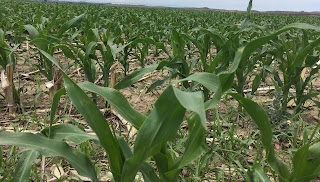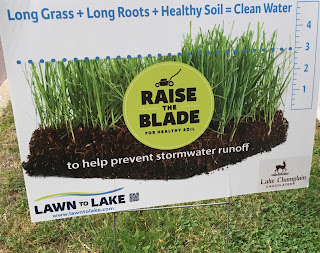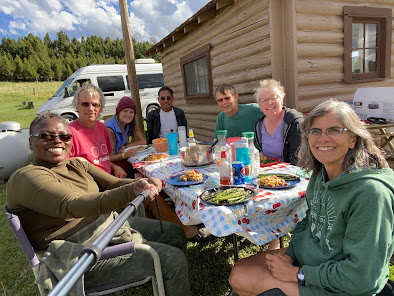Monoculture Crops
Riding 3670 miles across the United States meant a lot of scenery goes by. There is plenty of time to look around and notice the details. From a ride across South Dakota in the ‘80s I knew to expect a lot of corn as it is the USA's largest acreage cash crop. Where does all that “field corn” (as my farming grandfather called it) go? What was it used for? Of the 92 million acres of corn grown in the USA, one third is for feeding cows, pigs, and chickens, a third for making ethanol, and a third for exports to feed cows, pigs and chickens, and some for human consumption.
I also saw a lot of soy beans, America’s second largest cash crop at 88 million acres. I like edamame and soy sauce, but surely all those soy beans must be used for something else. Almost all the “meal” from soybeans goes to animal feed. 80% of the oil is consumed by humans. Nearly half the harvested beans are exported.
The monoculture “crop” that really surprised me the most as I pedaled down the road was yard grass. There are 40 to 50 million acres of lawns in the United States. I was passed by innumerable pickup trucks pulling trailers with a big riding mower or two, some push mowers, and the ever present smelly 2 stroke gas weed wackers. The sides of the trucks had clever lawn care company names (Plowz & Mowz Landscaping). I pass many more truck/trailers that were parked with the mowers in action. Most operators were very polite and stopped mowing until I biked by so I didn’t end up covered in lawn clippings.
On many of the byways I rode, there were homes on 1 to 5 acres, each with their own driveway, and most often an immense lawn from the road clear around the home and behind as well. I saw one home that was setback with at least 3 acres of front lawn. I even saw a dad mowing a field with a young son following in a miniature ATV / pretend lawn mower. By the time I stopped and got ready for the picture, the dad had paused mowing because the son had fallen too far behind and wasn't taking his "mowing job" seriously (or so I inferred). In the picture above, you can see the dad chatting with the son once the son caught up again.
Sitting on the bike, watching yard after yard go by, with most of them being mown if it was a Saturday morning, I got to wondering about the scale of so much lawn. It really hit home when I camped at the Brockport Welcome Center. No other sign got me thinking more about climate change, water quality, our local ecosystem, and personal free time than the notion using something besides grass for our yards. The sign talks about native pollinators, but from my perspective it was the solution to how to get rid of your lawn. When niece Erica asked what I was thinking one day as we were biking together, I mentioned lawns. Erica at first didn't comprehend what I was talking about. Then I realised brother Dave doesn't have any grass, no lawn mower, no weed whacker, and no time set aside every Saturday to take care of the lawn. He doesn't care about dandelions, fertilizing, or strange round rings of mushrooms causing any perceived imperfection. Erica didn't grow up with a lawn tradition. If only we were all as smart as my big brother Dave.
Text from the sign above:
A Home for Pollinators: Welcome to Brockport's Native Plant Garden
PLANTING FOR BIODIVERSITY
The Native Plant Garden has been designed to promote biodiversity by selecting plants native to New York State that have high ecological value. Many of the plants in the Garden support local pollinators and birds by providing what they need to survive - such as food, shelter, and nesting material. The result is a diverse garden that provides a rich visitor and educational experience while creating much needed native habitat. The Native Plant Garden hopes to inspire visitors to use this planting technique to leverage the vast amount of land dedicated to our public and private landscapes to regenerate lost native habitat.
NATIVE PLANTS & CONTEMPORARY DESIGN
The Garden has been curated to make a statement: gardens can be both beautiful and ecologically functional. Native plants are used in a way that mimics what occurs in a natural setting, while still heeding traditionally fundamental garden design principles - such as color, texture, height, and bloom time.
Plants with similar habits and needs have been combined to create a plant community that is able to remain diverse but still dense enough to reduce the spread of invasive weed species.
In the Native Plant Garden, the need for supplemental watering, soil amending and fertilizing has been reduced by selecting plants that have been matched to the existing dry, compacted, alkaline soils.
WHY POLLINATORS?
A pollinator is an animal that pollinates plants by moving pollen from the male reproductive parts to the female reproductive parts of the flower. Common pollinators are insects, but birds, bats and other mammals can also serve as pollinators. Often overlooked, pollinators provide critical services for both humans and the ecosystem as a whole by facilitating plant reproduction. Insects serve as a primary food source for many other members of the community making them a key component of the food web. Unfortunately, pollinator populations have been in decline. By supporting pollinator educational and using planting strategies similar to those used at the Native Plant Garden, we can all help support our native pollinators and our ecosystem.
THE ROLE OF NATIVE SPECIES
The Native Plant Garden is helping to reverse the damage to pollinator populations through the use of native plants. Native plants are necessary to support native pollinators because both pollinators and plants have established critical relationships through millions of years of simultaneous evolution. This is why the Native Plant Garden primarily uses plant species found growing natively in Monroe County. Although a non-native plant may still attract pollinators, non-native plants do not provide the same quality of habitat, nesting material, food sources, nectar sources, pollen or chemical properties as native plants.










Comments
Post a Comment